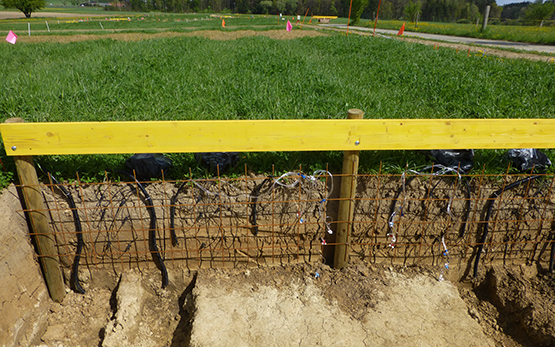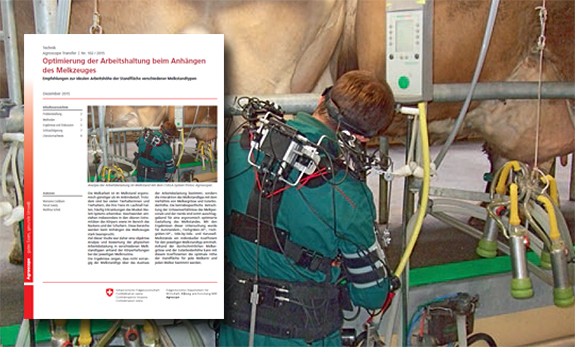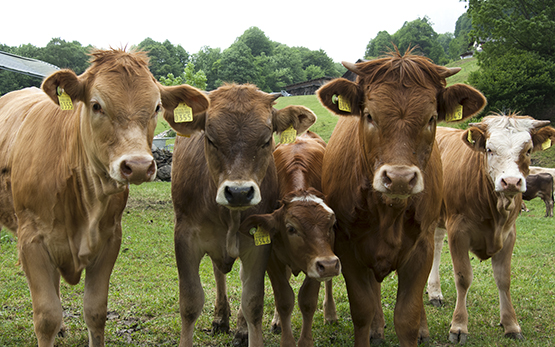Frei J., Wiesenberg G.L.B., Hirte J.
The impact of climate and potassium nutrition on crop yields: Insights from a 30-year swiss long-term fertilization experiment.
Agriculture, Ecosystems & Environment, 372, 2024, 1-14.
Zenkl R., Berlepsch-Valendas A., Liebisch F.
Food for thought: Towards circular nutrient economy in agriculture.
Hrsg. University of Zurich, University of Basel and ETH Zurich, 2024, 7 S.
Piccini C., Metzger K., Debaene G., Stenberg B., Götzinger S., Borůvka L., Sandén T., Bragazza L., Liebisch F.
In‐field soil spectroscopy in Vis–NIR range for fast and reliable soil analysis: A review.
European Journal of Soil Science, 75, (2), 2024, 1-18.
Yuzugullu O., Fajraoui N., Don A., Liebisch F.
Satellite-based soil organic carbon mapping on European soils using available datasets and support sampling.
Science of Remote Sensing, 9, 2024, 1-17.
Bernert G., Liebisch F.
Stickstoff-Injektionsdüngung mit CULTAN.
Hrsg. Agroscope, Merkblatt Nr. 190, 2023, 4 S.
weitere Sprachen: französisch | italienisch
Lorenzetti R., Castaldi F., Fondon C.L., Boruvka L., Metzger K., Ben-Dor E., Egmond van E., Barbetti R., Fantappie M., Debaene G., Klumpp K., Liebisch F., Gholizadeh A., Stenberg B., Knadel M.
The contribution of the European Project Probefield to in-field use of proximal soil sensors.
In: 2023 IEEE International Workshop on Metrology for Agriculture and Forestry. 6-8 November, Pisa. 2023.
Bernert G., Spiess E., Liebisch F.
CULTAN-Düngung reduziert die Stickstoffauswaschung bei gleichbleibendem Ertrag.
Agrarforschung Schweiz, 14, 2023, 207-213.
weitere Sprachen: französisch
Knapp S., Gunst L., Mäder P., Ghiasi S., Mayer J.
Organic cropping systems maintain yields but have lower yield levels and yield stability than conventional systems: Results from the DOK trial in Switzerland.
Field Crops Research, 302, 2023, 1-12.
Argento F., Bischoff W. A., Liebisch F.
Balancing carbon storage and groundwater quality in crop production in Switzerland.
In: European Healthy Soil Conference - 1st Edition: Soil Fertility. 14 September, Hrsg. FHNW School of Life Sciences / Agroscope, Muttenz. 2023, 1.
Schwalb S. A., Li S., Hemkemeyer S., Heinze S., Joergensen. R. G., Mayer J., Mäder P., Wichern F.
Long-term differences in fertilisation type change the bacteria:archaea:fungi ratios and reveal a heterogeneous response of the soil microbial ionome in a Haplic Luvisol.
Soil Biology and Biochemistry, 177, 2023, 1-11.
Nucera E., Huguenin-Elie O., Mayer J., Liebisch F., Spiess E.
Method for estimating nitrogen input by symbiotic fixation on Swiss farms.
Agroscope Science, 164, 2023, 1-49.
Bürge D.
Liste der für den ökologischen Leistungsnachweis zugelassenen Laboratorien 2023/24.
Hrsg. Agroscope, 2023, 2 S.
weitere Sprachen: französisch
Bürge D.
Liste der anerkannten Laboratorien für die Kontrolle der organischen Dünger.
Hrsg. Agroscope, 10. August, 2023, 4 S.
weitere Sprachen: französisch
Thiébaud E., Hafner D., Huber S., Giuliani G. , Meier T., Ringger C., Stüssi M., Liebisch F., Leifeld J., Oberholzer H., Kreft C., Huber R., Finger R., Bertschi M., Meili J. und weitere
CO2-Endbericht Ressourcenprojekt "AgroCO2ncept Flaachtal".
Hrsg. dss+ und Flury&Giuliani GmbH, 22. Mai, 2023, 125 S.
Hirte J., Liebisch F.
Crop response to soil potassium under diverse pedoclimatic conditions in multiple environments: Implications for fertilization recommendations.
In: Long Term Experiments: Meeting future challenges. 22 June, Rothamsted. 2023, 1-18.
Epper C. A., Ghiasi S., Liebisch F., Mayer J.
Re-evaluating the fertiliser nitrogen use efficiency using Swiss long term experiments.
In: Long Term Experiments: meeting future challenges. 20. June, Hrsg. Rothamsted research center, Rothamsted. 2023.
Argento F., Bischoff W. A., Hug R., Liebisch F.
CriticalN Jahresbericht 2022: Teil Ackerbau.
Hrsg. Bildungszentrum Wallierhof, Inforama und TerrAquat, 2023, 24 S.
Lori M., Hartmann M., Kundel D., Mayer J., Mueller R. C., Mäder P., Krause H.-M.
Soil microbial communities are sensitive to differences in fertilization intensity in organic and conventional farming systems.
FEMS Microbiology Ecology, 99, (6), 2023, 1-13.
Heinemann H., Hirte J., Seidel F., Don A.
Increasing root biomass derived carbon input to agricultural soils by genotype selection: A review.
Plant and Soil, In Press, 2023.
Frick H., Bischoff W.-A., Liebisch F.
Massnahmen zur Reduktion der Nitratauswaschung ins Grundwasser: Regionalisierter Massnahmenkatalog für das Nitratprojekt Niederbipp-Gäu-Olten (SO & BE).
Agroscope Science, 147, 2023, 1-134.
Epper C., Liebisch F., Mayer J.
Expert workshop on re-evaluating the potential nitrogen recovery of different manure categories: Workshop summary.
Agroscope Science, 157, 2023, 1-169.
Frick H., Bischoff W.-A., Schleicher S., Liebisch F.
Das Nitratprojekt Niederbipp-Gäu-Olten im Vergleich: Gebietsübersicht und Massnahmen.
2022, 88 S.
Jordan-Meile ., Higgins S., Dittert K., Cugnon T., Quemada M., Wall D., Bechini L., Marx S., Oenema O., Reijneveld A. , Liebisch F., Diedhiou K., Degan F., Denoroy P.
Comparison of Nitrogen Fertiliser recommendations in different West European countries.
In: International Fertilizer Society Proceedings. 9. December, Hrsg. International Fertiliser Society, Cambridge (UK). 2022, 1-33.
Krause H.-M., Stehle B., Mayer J., Mayer M., Steffens M., Mäder P., Fliessbach A.
Biological soil quality and soil organic carbon change in biodynamic, organic, and conventional farming systems after 42 years.
Agronomy for Sustainable Development, 42, 2022, 1-14.
Liebisch F.
(Neue) Instrumente zur Reduktion von Nährstoffverlusten aus der Landwirtschaft am Beispiel (Hof-) Dünger.
Umweltrecht in der Praxis = Le droit de l'environnement dans la pratique, 2022, (7), 2022, 759-770.
Steinfurth K., Holton Rubaek G., Hirte J., Buczko U.
Yield response of grass and grass-clover leys in crop rotations to phosphorus fertilization.
In: Grassland at the heart of circular and sustainable food systems. 26-30 June, Hrsg. European Grassland Federation, Caen (France). 2022, 731-733.
Bürge D.
Liste der für den ökologischen Leistungsnachweis zugelassenen Labors und für Bodenuntersuchungen für Düngeberatung empfohlenen Labors für die Anbauperiode 2022 / 2023.
Hrsg. Agroscope, Zürich. 2022, 2 S.
Bürge D.
Liste der anerkannten Laboratorien für die Kontrolle organischer Dünger.
Hrsg. Agroscope, Zürich. 14. Juli, 2022, 4 S.
Grossrieder J., Ringger C., Argento F., Grandgirard R., Anken T., Liebisch F.
Standortangepasste Stickstoffdüngung: aktuelle Methoden und Erfahrungen.
Agrarforschung Schweiz, (13), 2022, 103-113.
weitere Sprachen: französisch
Merz Q., Walter A., Maier, R., Hörtnagl L., Buchmann N., Kirchgessner N., Aasen H.
Relationship of leaf elongation rate of young wheat leaves, gross primary productivity and environmental variables in the field with hourly and daily temporal resolution.
Agricultural and Forest Meteorology, 320, 2022, 1-10.
Epper C.A., Mayer J., Liebisch F.
Revision Suisse-Bilanz: Ein angepasster Ansatz für die Bestimmung des ausgebrachten Stickstoffs im Hofdünger.
In: Fachausschuss Nährstoffbilanzen (dNPSM). 24. Mai, Online. 2022.
Argento F., Liebisch F.
Critical-N - Grundwasser schonende, produktive Landwirtschaft durch standortangepasster Stickstoffdüngung.
In: Flurbegehung im Gäu. 25. April, Hrsg. Bauernverband Gäu, Kestenholz. 2022.
Liebisch F.
(Neue) Instrumente zur Reduktion von Nährstoffverlusten aus der Landwirtschaft am Beispiel der (Hof)dünger.
In: Pflanzenschutzmittel und Nährstoffverluste in der Landwirtschaft – Rechtliche Instrumente zum Schutz der Umwelt. 15. Juni, Hrsg. Vereinigung für Umweltrecht (VUR), Solothurn. 2022, 1-23.
Steinfurth K., Börjesson G., Denoroy P., Eichler-Löbermann B., Gans W., Heyn J., Hirte J., Huyghebaert B., Jouany C., Koch D., Merbach I., Mokry M., Mollier A., Morel C., Panten K. und weitere
Thresholds of target phosphorus fertility classes in European fertilizer recommendations in relation to critical soil test phosphorus values derived from the analysis of 55 European long-term field experiments.
Agriculture Ecosystems and Environment, 332, (107926), 2022.
Argento F., Liebisch F., Simmler M., Ringger C., Hatt M., Walter A., Anken T.
Linking soil N dynamics and plant N uptake by means of sensor support.
European Journal of Agronomy, 134, 2022, 126462-126472.
Hirte J., Liebisch F., Heller O., Weisskopf P., Weyermann I., Baumann P., Keller A., Bürge D.
Die Schweizer Bestimmungsmethoden für pflanzenverfügbare Gehalte an Phosphor (P), Kalium (K), Calcium (Ca) und Magnesium (Mg) im Boden. Möglichkeiten, Grenzen und Entwicklungspotential.
In: BDU Kolloquium. 13. April, Agridea (online). 2022, 1-20.
Hirte J., Liebisch F., Heller O., Weisskopf P., Weyermann I., Baumann P., Keller A., Bürge D.
Die Schweizer Bestimmungsmethoden für pflanzenverfügbare Gehalte an Phosphor, Kalium, Magnesium und Calcium im Boden.
Agroscope Science, 129, 2022, 1-20.
weitere Sprachen: französisch
Hirte J.
Pedoklimatische Einflüsse auf kritische Phosphorgehalte im Boden - von Klassifikationen hin zu numerischen Modellen für standortangepasste Düngung.
In: Nachhaltigkeitstagung 2022. 27.01., Hrsg. Agroscope, Agroscope. 2022, 1-14.








